词汇学复习题
- 格式:doc
- 大小:39.00 KB
- 文档页数:5
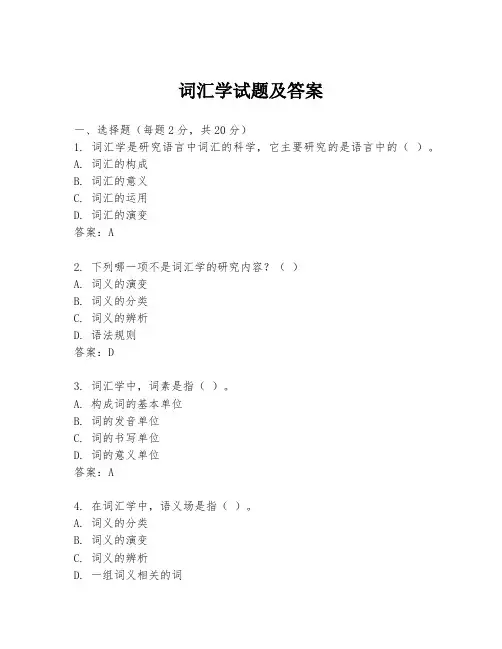
词汇学试题及答案一、选择题(每题2分,共20分)1. 词汇学是研究语言中词汇的科学,它主要研究的是语言中的()。
A. 词汇的构成B. 词汇的意义C. 词汇的运用D. 词汇的演变答案:A2. 下列哪一项不是词汇学的研究内容?()A. 词义的演变B. 词义的分类C. 词义的辨析D. 语法规则答案:D3. 词汇学中,词素是指()。
A. 构成词的基本单位B. 词的发音单位C. 词的书写单位D. 词的意义单位答案:A4. 在词汇学中,语义场是指()。
A. 词义的分类B. 词义的演变C. 词义的辨析D. 一组词义相关的词答案:D5. 词汇学研究中,同义词是指()。
A. 意义完全相同的词B. 意义相近的词C. 形式相同的词D. 用法相同的词答案:B6. 下列哪一项不是词汇学中词义的分类?()A. 抽象意义B. 具体意义C. 语法意义D. 色彩意义答案:C7. 词汇学中,词义的演变通常包括()。
A. 词义的扩大B. 词义的缩小C. 词义的转移D. 以上都是答案:D8. 词汇学中,词义的辨析主要研究的是()。
A. 词与词之间的联系B. 词与词之间的差异C. 词与词之间的相似性D. 词与词之间的对立答案:B9. 在词汇学中,词义的模糊性是指()。
A. 词义的不确定性B. 词义的明确性C. 词义的多重性D. 词义的单一性答案:A10. 词汇学中,词义的多义性是指()。
A. 一个词有多种意义B. 一个词只有一种意义C. 一个词的意义是固定的D. 一个词的意义是单一的答案:A二、填空题(每题2分,共20分)1. 词汇学中的词素是指构成词的________。
答案:基本单位2. 语义场是指一组________的词。
答案:词义相关3. 同义词是指意义________的词。
答案:相近4. 词义的演变包括词义的________、________和________。
答案:扩大、缩小、转移5. 词义的辨析主要研究的是词与词之间的________。
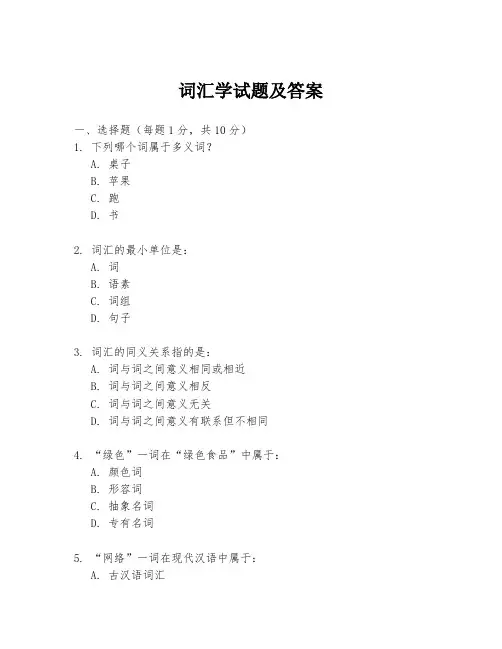
词汇学试题及答案一、选择题(每题1分,共10分)1. 下列哪个词属于多义词?A. 桌子B. 苹果C. 跑D. 书2. 词汇的最小单位是:A. 词B. 语素C. 词组D. 句子3. 词汇的同义关系指的是:A. 词与词之间意义相同或相近B. 词与词之间意义相反C. 词与词之间意义无关D. 词与词之间意义有联系但不相同4. “绿色”一词在“绿色食品”中属于:A. 颜色词B. 形容词C. 抽象名词D. 专有名词5. “网络”一词在现代汉语中属于:A. 古汉语词汇B. 外来词C. 新词D. 专业术语6. 下列哪个词属于反义词?A. 快-慢B. 男-女C. 长-短D. 老-少7. 词汇的构成方式不包括:A. 合成B. 派生C. 借用D. 音译8. “美丽”一词的词性是:A. 名词B. 动词C. 形容词D. 副词9. “电脑”一词的构词方式是:A. 合成B. 派生C. 借用D. 音译10. 下列哪个词属于外来词?A. 电视B. 电话C. 网络D. 汽车二、填空题(每空1分,共10分)11. 词汇学是研究语言中________的学科。
12. 词义的演变通常包括词义的________、________和________。
13. 词义的________是指词义在特定语境下临时改变的现象。
14. 词汇的________是指词义的扩大,能够涵盖更多的事物或现象。
15. 词汇的________是指词义的缩小,只能指特定的事物或现象。
三、简答题(每题5分,共10分)16. 简述词汇的构成方式有哪些?17. 简述词义演变的类型。
四、论述题(每题15分,共30分)18. 论述词汇学在语言教学中的重要性。
19. 论述词汇的同义关系和反义关系在语言表达中的作用。
五、案例分析题(共40分)20. 请分析“手机”一词的词义演变过程,并讨论其对现代汉语词汇发展的影响。
(20分)21. 以“环保”为例,分析词汇的派生构成方式及其在现代社会中的应用。
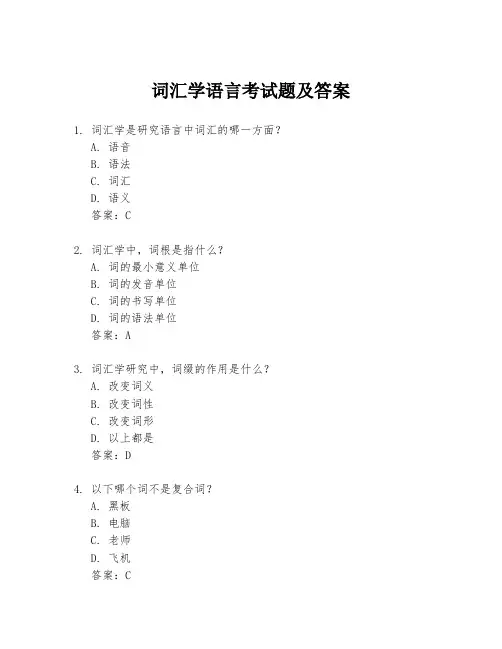
词汇学语言考试题及答案1. 词汇学是研究语言中词汇的哪一方面?A. 语音B. 语法C. 词汇D. 语义答案:C2. 词汇学中,词根是指什么?A. 词的最小意义单位B. 词的发音单位C. 词的书写单位D. 词的语法单位答案:A3. 词汇学研究中,词缀的作用是什么?A. 改变词义B. 改变词性C. 改变词形D. 以上都是答案:D4. 以下哪个词不是复合词?A. 黑板B. 电脑C. 老师D. 飞机答案:C5. 词汇学中,同义词是指什么?A. 意义完全相同的词B. 意义相近的词C. 意义相反的词D. 形式相同的词答案:B6. 词汇学中,反义词是指什么?A. 意义完全相同的词B. 意义相近的词C. 意义相反的词D. 形式相同的词答案:C7. 词汇学研究中,词义的演变叫做什么?A. 词义变化B. 词义发展C. 词义演变D. 词义扩展答案:C8. 词汇学中,词义的缩小指的是什么?A. 词义变得更加具体B. 词义变得更加抽象C. 词义变得更加广泛D. 词义保持不变答案:A9. 词汇学研究中,词义的扩大指的是什么?A. 词义变得更加具体B. 词义变得更加抽象C. 词义变得更加广泛D. 词义保持不变答案:C10. 词汇学中,词义的转移指的是什么?A. 词义变得更加具体B. 词义变得更加抽象C. 词义从一个领域转移到另一个领域D. 词义保持不变答案:C。
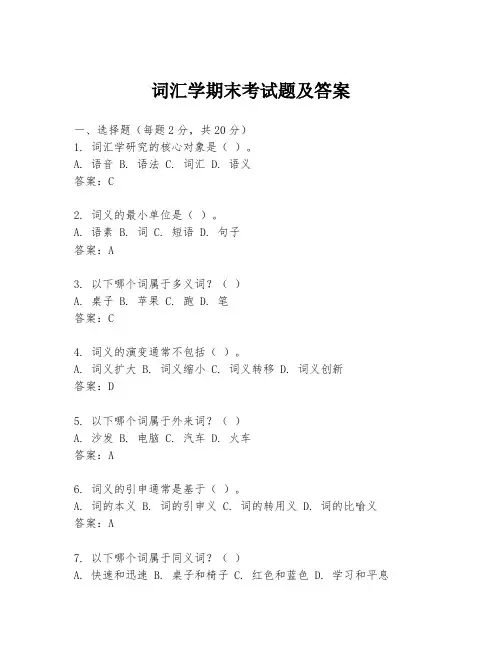
词汇学期末考试题及答案一、选择题(每题2分,共20分)1. 词汇学研究的核心对象是()。
A. 语音B. 语法C. 词汇D. 语义答案:C2. 词义的最小单位是()。
A. 语素B. 词C. 短语D. 句子答案:A3. 以下哪个词属于多义词?()A. 桌子B. 苹果C. 跑D. 笔答案:C4. 词义的演变通常不包括()。
A. 词义扩大B. 词义缩小C. 词义转移D. 词义创新答案:D5. 以下哪个词属于外来词?()A. 沙发B. 电脑C. 汽车D. 火车答案:A6. 词义的引申通常是基于()。
A. 词的本义B. 词的引申义C. 词的转用义D. 词的比喻义答案:A7. 以下哪个词属于同义词?()A. 快速和迅速B. 桌子和椅子C. 红色和蓝色D. 学习和平息答案:A8. 以下哪个词属于反义词?()A. 高和矮B. 桌子和椅子C. 红色和蓝色D. 学习和平息答案:A9. 以下哪个词属于成语?()A. 马到成功B. 桌子C. 红色D. 学习答案:A10. 以下哪个词属于专业术语?()A. 电脑B. 桌子C. 红色D. 学习答案:A二、填空题(每题2分,共20分)1. 词汇学是研究语言中的词汇及其变化规律的学科。
2. 词义的演变包括词义扩大、词义缩小和词义转移。
3. 多义词是指一个词具有两个或两个以上相关或不相关的意义。
4. 外来词是指从其他语言借用过来的词。
5. 词义的引申通常是基于词的本义。
6. 同义词是指意义相同或相近的词。
7. 反义词是指意义相反或相对的词。
8. 成语是指由四个或四个以上汉字组成的固定短语,具有特定的意义和用法。
9. 专业术语是指在特定领域内使用的具有特定意义的词。
10. 词汇的创新是指根据语言发展的需要,创造出新的词汇。
三、简答题(每题10分,共40分)1. 简述词汇学的研究内容。
词汇学主要研究语言中的词汇及其变化规律,包括词的构成、词义的演变、词的分类、词的用法等方面。
2. 简述词义演变的类型。
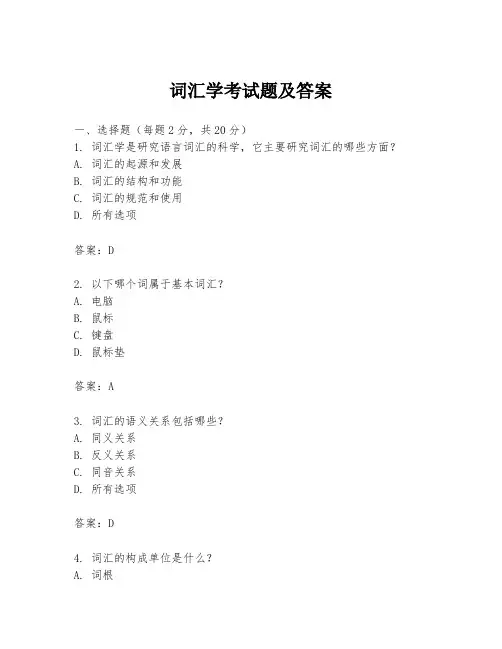
词汇学考试题及答案一、选择题(每题2分,共20分)1. 词汇学是研究语言词汇的科学,它主要研究词汇的哪些方面?A. 词汇的起源和发展B. 词汇的结构和功能C. 词汇的规范和使用D. 所有选项答案:D2. 以下哪个词属于基本词汇?A. 电脑B. 鼠标C. 键盘D. 鼠标垫答案:A3. 词汇的语义关系包括哪些?A. 同义关系B. 反义关系C. 同音关系D. 所有选项答案:D4. 词汇的构成单位是什么?A. 词根B. 词缀C. 词尾D. 所有选项答案:D5. 词汇的演变通常包括哪些过程?A. 词义的扩大B. 词义的缩小C. 词义的转移D. 所有选项答案:D6. 词汇的借用通常发生在哪些语言之间?A. 亲属语言B. 非亲属语言C. 任何语言D. 所有选项答案:C7. 以下哪个词属于外来词?A. 沙发B. 苹果C. 桌子D. 椅子答案:A8. 词汇的标准化通常由哪个机构进行?A. 教育部门B. 语言委员会C. 出版社D. 所有选项答案:B9. 词汇的语义变化通常受到哪些因素的影响?A. 社会文化B. 科技发展C. 语言接触D. 所有选项答案:D10. 词汇的创新通常发生在哪些领域?A. 文学创作B. 科技发明C. 日常生活D. 所有选项答案:D二、填空题(每题2分,共20分)1. 词汇学研究词汇的______、______、______和______。
答案:起源、发展、结构、功能2. 基本词汇通常包括______、______、______等。
答案:自然现象、人体部位、基本动作3. 词汇的语义关系包括______、______、______等。
答案:同义、反义、上下义4. 词汇的构成单位主要有______、______和______。
答案:词根、词缀、词尾5. 词汇的演变过程包括______、______和______。
答案:词义扩大、词义缩小、词义转移6. 词汇的借用通常发生在______和______之间。
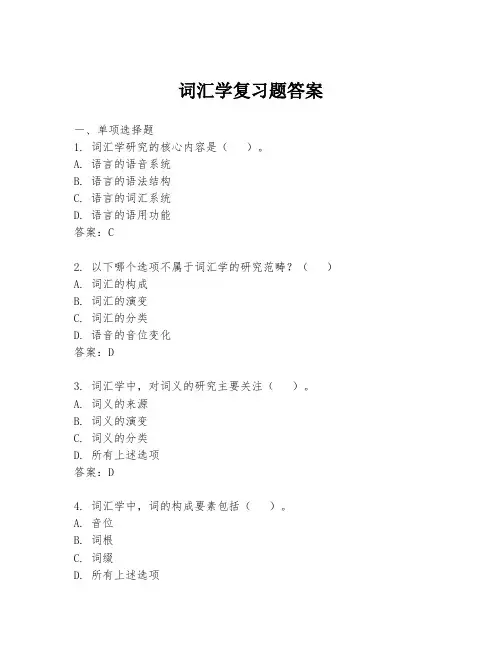
词汇学复习题答案一、单项选择题1. 词汇学研究的核心内容是()。
A. 语言的语音系统B. 语言的语法结构C. 语言的词汇系统D. 语言的语用功能答案:C2. 以下哪个选项不属于词汇学的研究范畴?()A. 词汇的构成B. 词汇的演变C. 词汇的分类D. 语音的音位变化答案:D3. 词汇学中,对词义的研究主要关注()。
A. 词义的来源B. 词义的演变C. 词义的分类D. 所有上述选项答案:D4. 词汇学中,词的构成要素包括()。
A. 音位B. 词根C. 词缀D. 所有上述选项答案:D5. 词汇学研究中,对词汇的分类主要依据()。
A. 词的形态B. 词的语法功能C. 词的意义D. 词的使用频率答案:B二、填空题1. 词汇学是研究语言中词汇的构成、意义、使用和发展变化规律的学科。
2. 词汇学的研究对象包括词、短语、成语等语言单位。
3. 词义的演变通常包括词义的扩大、缩小、转移和分化。
4. 词汇的分类可以根据词的语法功能、语义特征和使用场合等标准进行。
5. 词汇学的研究方法包括比较法、历史法和结构法等。
三、简答题1. 简述词汇学的主要研究内容。
答:词汇学的主要研究内容包括词的构成、词义、词汇的分类、词汇的使用和发展变化等。
2. 词汇学与语法学的主要区别是什么?答:词汇学主要研究词汇的构成、意义和使用,而语法学则研究句子的结构和成分之间的关系。
3. 词汇学中,词义的研究有哪些主要方法?答:词汇学中,词义的研究方法包括语义场分析、词义演变分析、词义对比分析等。
四、论述题1. 论述词汇学在语言教学中的作用。
答:词汇学在语言教学中的作用主要体现在帮助学习者理解词汇的构成和意义,掌握词汇的使用规则,提高词汇学习效率,以及通过词汇学的研究方法,促进学习者对语言的深入理解和应用能力的提升。
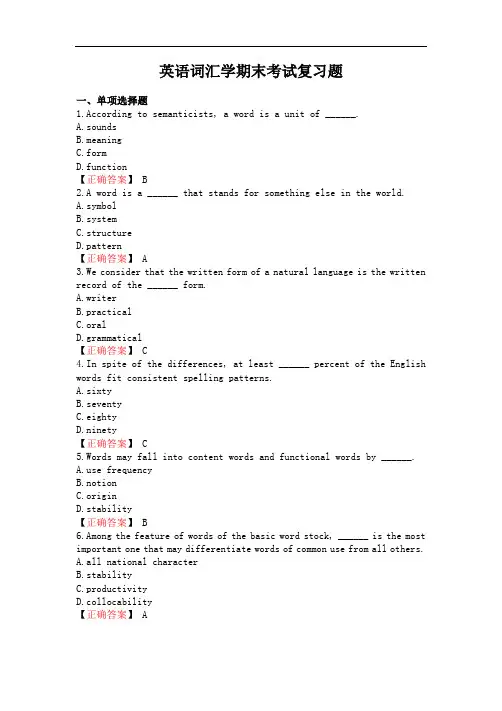
英语词汇学期末考试复习题一、单项选择题1.According to semanticists, a word is a unit of ______.A.soundsB.meaningC.formD.function【正确答案】 B2.A word is a ______ that stands for something else in the world.A.symbolB.systemC.structureD.pattern【正确答案】 A3.We consider that the written form of a natural language is the written record of the ______ form.A.writerB.practicalC.oralD.grammatical【正确答案】 C4.In spite of the differences, at least ______ percent of the English words fit consistent spelling patterns.A.sixtyB.seventyC.eightyD.ninety【正确答案】 C5.Words may fall into content words and functional words by ______.e frequencyB.notionC.originD.stability【正确答案】 B6.Among the feature of words of the basic word stock, ______ is the most important one that may differentiate words of common use from all others.A.all national characterB.stabilityC.productivityD.collocability【正确答案】 A7.______ belong to the sub-standard language, a category that seems to stand between the standard general words including informal ones available to everyone and in-group words.A.JargonsB.SlangsC.ArgotsD.Dialectal words【正确答案】 B8.Native words in English are words brought to Britain in the ______ century by some German tribes.A.eighthB.seventhC.fifthD.sixth【正确答案】 C9.Which of the following words isn’t the alien?A.decorB.bazaarC.shiftD.emir【正确答案】 C10._______ are words or forms that were once in common use but are now restricted only to specialized or limited use.A.ArchaismsB.SlangC.ArgotD.Dialectal words【正确答案】 A11.The Indo-European language family accordingly fall into _______ principle groups, which can be grouped into an Eastern set and Western set.A.eightB.sixC.fiveD.several【正确答案】 A12.The first peoples known to inhabit England were ______.A.CeltsB.RomansC.Anglo-SaxonsD.Jutes【正确答案】 A13.Old English has a vocabulary of about ______ words.A.30000 to 40000B.40000 to 50000C.50000 to 60000D.60000 to 70000【正确答案】 C14.Between 1250 and 1500 about ______ words of French poured into English.A.7000B.8000C.9000D.10000【正确答案】 Cually we regard which of the following periods as Early Modern English?A.450 to 1150B.1150 to 1500C.1500 to 1600D.1500 to 1700【正确答案】 D16.In the growth of present-day English vocabulary, there are three main sources of new words: the rapid development of modern science and technology; social, economic and political changes; the influence of ______.A.the educational systemB.other cultures and languagesC.the government systemD.the society changes【正确答案】 B17.In modern times, ______ is the most important way of vocabulary expansion.A.creationB.semantic changeC.borrowingD.reviving archaic or obsolete words【正确答案】 A18.American English like to use ______.A.creationB.reviving archaic or obsolete wordsC.semantic changeD.borrowing【正确答案】 B19.In the Eastern set, _______ and ________ are each the only modern language respectively.A.Italic, GermanicB.Armenian, AlbanianC.Celtic, HellenicD.Balto-Slavic, Into-Iranian【正确答案】 B20.The ________ is made up of most of the languages of Europe, the Near East, and India.A.GermanicB.Balto-SlavicC.Indo-EuropeanD.Indo-Iranian【正确答案】 C21.______ is the smallest functioning unite in the composition of words.A.MorphemeB.AllomorphC.WordD.Stem【正确答案】 A22.______are abstract units.A.MorphsB.AllomorphsC.MorphemesD.All of the above【正确答案】 C23.The morpheme is to the morph what a_____is to a______.A.word / soundB.root / affixC.stem / affixD.phoneme / phone【正确答案】 D24.Bound morphemes include ______ and affix.A.stemB.rootC.bound rootD.prefix and suffix【正确答案】 C25.Words produced by conversion are primarily ______.A.nounsB.adjectivesC.verbsD.all the above【正确答案】 D26.______are attached to the end of words to indicate grammatical relationships.A.AffixesB.SuffixesC.Inflectional affixesD.None of the above【正确答案】 C27.The number of inflectional affixes is ______.A.small and changeablerge and changeableC.small and stablerge and stable【正确答案】 C28.Desire, desirable and desired are______.A.rootsB.stemsC.free rootsD.roots as well as stems【正确答案】 B29.Almost all affixes are_________because few can be used as independent words.A.free morphemesB.bound morphemesC.bound rootD.inflectional affixes【正确答案】 B30.A_________is a bound form and has to combine with other morphemes to make words.A.free rootB.bound rootC.free morphemesD.inflectional affixes【正确答案】 B31._____doesn’t belong to the most productive means of word-formation.A.AffixationpoundingC.ConversionD.Blending【正确答案】 D32.Prefixes do not generally change the ____ of the stem but only modify its meaning.A.word-classB.soundC.formD.structure【正确答案】 A33.All of the following are pejorative prefixes except ______.A.mal-B.arch-C.pseudo-D.mis-【正确答案】 B34.-eer, -er, -ess, -ette, -let are all suffixes added to noun bases to produce _____ nouns.A.abstractB.de-verbalC.concreteD.de-adjective【正确答案】 C35.The conversion of two-syllable nouns into verbs involves a change of______.A.spellingB.pronunciationC.stressD.function【正确答案】 C36.The overwhelming majority of blends are ______.A.verbsB.adjectivesC.nounsD.numbers【正确答案】 C37.Back-formation is the method of creating new words by ______ theso-called suffixes.A.removingbiningC.shorteningD.considering【正确答案】 A38.There are four common types of clipping: _______, _______, ________ and ________.A.front clipping, back clipping, front and back clipping, phrase clippingB.front clipping, back clipping, front and back clipping, middle clippingC.front clipping, back clipping, middle clipping, phrase clippingD.front clipping, front and back clipping, middle clipping, phrase clipping【正确答案】 A39.Some words are from characters in mythology, e. g. cherub from _______.A.CherubB.GodC.ProteusD.Mackintosh【正确答案】 A40.Stylistically, back-formed words are largely ________ and some of them have not gained public acceptance.A.formalB.adjectivesC.human nounsrmal【正确答案】 D41.Most verbs converted from adjectives have both transitive and ________ functions.A.intransitiveB.voicelessC.linkD.adjective【正确答案】 A42.Most compounds consist of only _______ stems.A.oneB.twoC.threeD.four【正确答案】 B43.Words are but symbols, many of which have meaning only when they have acquired ______.A.referenceB.formC.connectionD.motivation【正确答案】 A44.The connection between the word-meaning and the thing it refers to is ______.A.logicalB.conventionalC.grammaticalD.formal【正确答案】 B45.Generally speaking, the meaning of ‘meaning’ is pe rhaps what is termed _______.A.conceptB.ideaC.conventionD.sense【正确答案】 D46._______ meaning and grammatical meaning make up the word-meaning.A.ConceptualB.LexicalC.SocialD.Associative【正确答案】 B47.________ indicates the speaker’s attitude towards the person or thing in question.A.Connotative meaningB.Stylistic meaningC.Collocative meaningD.Affective meaning【正确答案】 D48._______, though having little lexical meaning, possess strong grammatical meaning.A.Content wordsB.Functional wordsC.Borrowed wordsD.Native words【正确答案】 B49.Black market means _______.A.‘the market black in colour’B.‘illegal selling and buying’C.‘the market having many people’D.none of the above【正确答案】 B50._____ is a common feature peculiar to all natural languages.A.HomonymyB.PolysemyC.SynonymyD.Antonymy【正确答案】 B51.The problem of interrelation of the various meanings of the same word can be dealt with from diachronic and ______.putationalB.historical approachC.synchronic approachparative approach【正确答案】 C52.The differences between synonyms boil down to the following except ______.A.denotationB.connotationC.applicationD.pronunciation【正确答案】 D53.______ means the stylistic and emotive colouring of words.A.PronunciationB.ConnotationC.DenotationD.Application【正确答案】 B54._______ truly represent oppositeness of meaning.A.Contradictory termsB.Contray termsC.Relative termsD.Absolute synonyms【正确答案】 A55.The basic meaning of a word is the core of word-meaning called the _______ meaning.A.firstB.derivedC.centralD.none of the above【正确答案】 C56.Absolute synonyms are_______ in natural languages.A.numerousB.rareC.popularmon【正确答案】 B57.________ deals with the relationship of semantic inclusion.A.PolysemyB.HomoymyC.AntonymyD.Hyponymy【正确答案】 D58.Which of the following is not the antonym of dull?A.sunnyB.sharpC.acuteD.fast【正确答案】 D59.________ are best viewed in terms of a scale running between two poles or extremes.A.Contradictory termsB.Contrary termsC.Relative termsD.Antonyms【正确答案】 B60.________ is concerned with semantic opposition.A.AntonymyB.HomonymyC.PolysemyD.Hyponymy【正确答案】 A61.Consequence means________.A.smallB.happinessC.expandD.result【正确答案】 D62.Among the types of word-meaning changes, ______ and narrowing are the most common by far.A.degradationB.transferC.elevationD.extension【正确答案】 D63.Extension of meaning is also called ______.A.generalizationB.specializationC.characterizationD.popularization【正确答案】 A64.Narrowing of meaning is also called ______.A.generalizationB.specializationC.characterizationD.popularization【正确答案】 B65.Words which were used to designate one thing but later changed to mean something else have experienced process of semantic _____.A.extensionB.degradationC.transferD.elevation【正确答案】 C66.The attitudes of classes have also made inroads into lexical meaning in the case of _____.A.narrowingB.extensionC.degradationD.transfer【正确答案】 C。
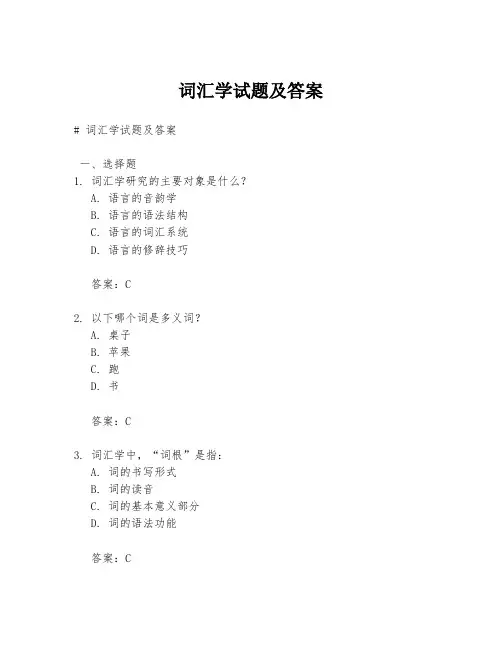
词汇学试题及答案# 词汇学试题及答案一、选择题1. 词汇学研究的主要对象是什么?A. 语言的音韵学B. 语言的语法结构C. 语言的词汇系统D. 语言的修辞技巧答案:C2. 以下哪个词是多义词?A. 桌子B. 苹果C. 跑D. 书答案:C3. 词汇学中,“词根”是指:A. 词的书写形式B. 词的读音C. 词的基本意义部分D. 词的语法功能答案:C4. 以下哪个词属于派生词?A. 快乐B. 快速C. 快车D. 快答案:B5. 词汇学中的“同形异义词”指的是:A. 音同形异的词B. 形同义异的词C. 音同义异的词D. 形同音异的词答案:B二、填空题1. 词汇学是研究语言中______的学科。
答案:词汇2. 一个词可以有多个意义,这种现象称为词的______。
答案:多义性3. 词义的扩大是指词义范围______。
答案:扩大4. 词义的缩小是指词义范围______。
答案:缩小5. 词义的转移是指词义从一种事物转移到______。
答案:另一种事物三、简答题1. 简述词汇学中“词义”的概念。
答案:词义是指词所表达的意义,它包括词的字面意义和引申意义。
词义是语言中最基本的语义单位,是词汇学研究的核心内容。
词义不仅包括词的直接意义,还可能包含情感色彩、文化背景等附加意义。
2. 解释“词义的引申”。
答案:词义的引申是指词义从其原始意义出发,通过联想、比喻等方式,扩展到新的领域或情境中。
引申义通常与原义有逻辑上的联系,但并不完全相同。
例如,“苹果”最初指一种水果,后来引申为苹果公司的产品。
3. 描述“词义的模糊性”。
答案:词义的模糊性是指词义的界限不明确,一个词可以有多个相近但又不完全相同的意义。
这种模糊性使得语言更加灵活,但也可能导致理解上的歧义。
词义的模糊性是语言自然发展的结果,也是语言多样性的体现。
四、论述题1. 论述词汇学在语言教学中的作用。
答案:词汇学在语言教学中扮演着至关重要的角色。
首先,它帮助学习者理解词汇的构成和变化规律,从而更有效地记忆和使用词汇。
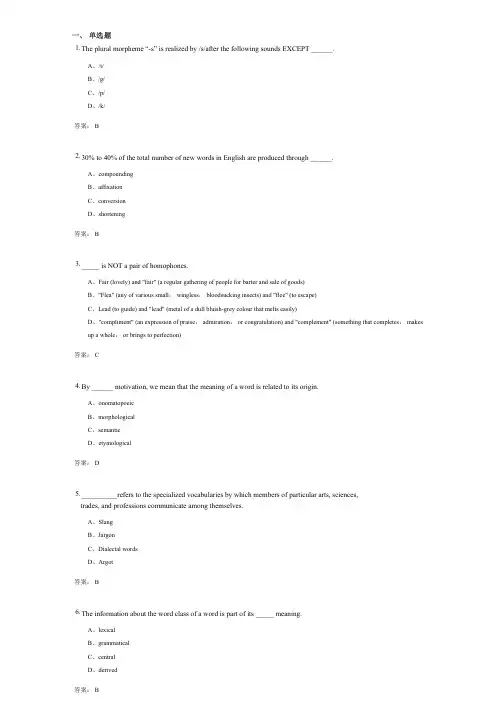
一、单选题1.The plural morpheme “-s” is realized by /s/after the following sounds EXCEPT ______.A、/t/B、/g/C、/p/D、/k/答案: B2.30% to 40% of the total number of new words in English are produced through ______.A、compoundingB、affixationC、conversionD、shortening答案: B3._____ is NOT a pair of homophones.A、Fair (lovely) and "fair" (a regular gathering of people for barter and sale of goods)B、"Flea" (any of various small, wingless, bloodsucking insects) and "flee" (to escape)C、Lead (to guide) and "lead" (metal of a dull bluish-grey colour that melts easily)D、"compliment" (an expression of praise, admiration, or congratulation) and "complement" (something that completes, makesup a whole, or brings to perfection)答案: C4.By ______ motivation, we mean that the meaning of a word is related to its origin.A、onomatopoeicB、morphologicalC、semanticD、etymological答案: D5.__________refers to the specialized vocabularies by which members of particular arts, sciences,trades, and professions communicate among themselves.A、SlangB、JargonC、Dialectal wordsD、Argot答案: B6.The information about the word class of a word is part of its _____ meaning.A、lexicalB、grammaticalC、centralD、derived答案: B二、 判断题7.A word is the combination of form and ________.A 、spellingB 、writingC 、meaningD 、denoting答案: C8.The following words have derivational affixes EXCEPT ______.A 、worksB 、prewarC 、postwarD 、bloody答案: A1.The most important mode of vocabulary development in present - day English is creation of newwords by means of word formation.A 、正确B 、错误答案: 正确2.Simple words in English are usually non-motivated.A 、正确B 、错误答案: 正确3.When a prefix is added to a word, its word-class is usually changed.A 、正确B 、错误答案: 错误4.Lexical meaning is dominant in content words.A 、正确B 、错误答案: 正确pounds are words formed by combining affixes and stem.A 、正确B 、错误答案: 错误6.Quite a number of derivational affixes have more than one meaning.A 、正确B 、错误答案: 正确三、 名词解释四、 问答题7.Unlike conceptual meaning, associative meaning is unstable and indeterminate.A 、正确B 、错误答案: 正确ponential analysis has no disadvantages.A 、正确B 、错误答案: 错误9.In most cases, the native term is more literary than the foreign one.A 、正确B 、错误答案: 错误10.Grammatical meaning refers to the part of speech tenses of verbs and stylistic features of words.A 、正确B 、错误答案: 错误1.Acronymy答案: is the process of forming new words by joining the initial letters of names of social and political organizations or special noun phrases and technical terms.2.Morphs答案: Morphemes are abstract units, which are realized in speech by discrete units known as morphs. They are actual spoken, minimal carriers of meaning.3.Etymological Motivation答案: The history of the word explains the meaning of the word4.Sentence Idioms答案: are mainly proverbs and sayings including colloquialisms and catchphrases. Each function as a sentence.1.Contradictory terms 有一个最大的特点是什么?答案: Mutually exclusive and are non-gradable, They cannot be used in comparative degrees and do not allow adverbs of intensity like very to qualify them.。
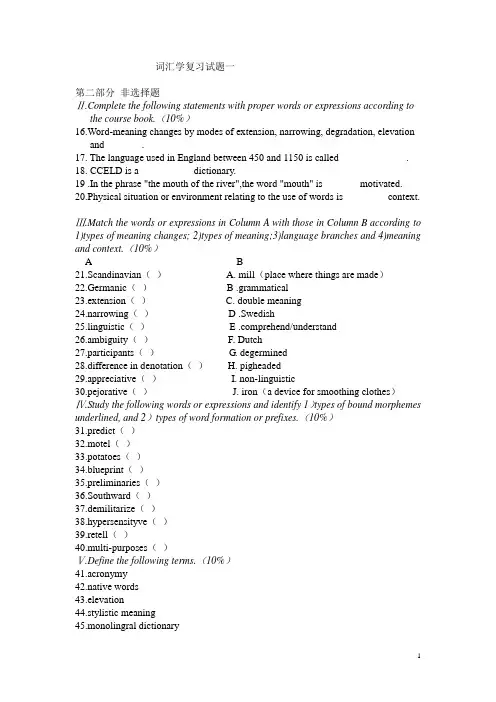
词汇学复习试题一第二部分非选择题Ⅱ.Complete the following statements with proper words or expressions according to the course book.(10%)16.Word-meaning changes by modes of extension, narrowing, degradation, elevationand _______.17. The language used in England between 450 and 1150 is called _____________.18. CCELD is a __________ dictionary.19 .In the phrase "the mouth of the river",the word "mouth" is _______motivated.20.Physical situation or environment relating to the use of words is ________ context.Ⅲ.Match the words or expressions in Column A with those in Column B according to 1)types of meaning changes; 2)types of meaning;3)language branches and 4)meaning and context.(10%)A B21.Scandinavian() A. mill(place where things are made)22.Germanic() B .grammatical23.extension() C. double meaning24.narrowing() D .Swedish25.linguistic() E .comprehend/understand26.ambiguity() F. Dutch27.participants()G. degermined28.difference in denotation()H. pigheaded29.appreciative()I. non-linguistic30.pejorative()J. iron(a device for smoothing clothes)Ⅳ.Study the following words or expressions and identify 1)types of bound morphemes underlined, and 2)types of word formation or prefixes.(10%)31.predict()32.motel()33.potatoes()34.blueprint()35.preliminaries()36.Southward()37.demilitarize()38.hypersensityve()39.retell()40.multi-purposes()Ⅴ.Define the following terms.(10%)41.acronymy42.native words43.elevation44.stylistic meaning45.monolingral dictionaryⅥ.Answer the following questions. Your answers should the clear and short. Write your answers in the space given below.(12%)46.How many types of motivation are there in English? Give ONE example for eachtype.47.What are the major sources of English synonyms? Illustrate your points.48.What are the clues generally provided in verbal context?Ⅶ.Analyze and comment on the following. Write your answers in the space given below.(18%)49.Analyze the morphological structures of following words and point out the typesof the morphemes.Recollection, nationalist, unearthly50.Pick out the idioms in the following extract and explain its origin and the effect ofusing this form."Well, it's the old story of the stitch in time," he said.复习一答案Ⅱ.(10%)16.transfer 17.OLD English 18.monolingual 19.semantically 20.extralinguistic/non-linguisticⅢ.(10%)21.D 22.F 23.A 24.J 25.B 26.C 27.I 28.E 29.G 30.HⅣ.(10%)31.bound root 32.(head+tail)blinding 33.inflectional affix/morpheme 34.a+n35.full conversion 36.suffix 37.reversativ 38.prefix of degree 39.prefix40.number prefixⅤ.(10%)41.The process of forming new words by joining the initial letters of names of organizations or special noun phrases and technical terms.42.Native words, also known as Anglo-Saxon words, are words brought to Britian in the 5th century by the Germanic tribes.43.The process by which words rise from humble beginnings to positions of importance.44.The distinctive stylistic features of words which make them appropriate for different context.45.A dictionary written in one language, or a dictionary in which entries are defined in the same language.Ⅵ.(12%)46.There are four types of motivation:1)Onomatopoeic motivation, e.g. cuckoo, squeak, quack, etc.2)Morphological motivation, e.g. airmail, reading-lamp, etc.3)Semantic motivation, e.g. the mouth of the river, the foot of the mountain, etc. 4)Etymological motivation, e.g. pen, laconic, etc.47.Key points:borrowing; dialects and regional English; figurative and euphemistic use of words; coincidence with idiomatic expressions.48.Key points:definition; explanation; example; synonymy; antonymy; hyponymy; relevant details and word structure.Ⅶ.(18%)49.1)Each of the three words consists of three morphemes, recollection (re+collect+ion),nationalist(nation+al+ist),unearthly(un+earth+ly).2)Of the nine morphemes, only "collect","nation" and "earth" are free morphemes as they can exist by themselves.3)All the rest re-,-ion,-al,-ist,un- and -ly are bound as none of them can stand alone as words.50.1)the stitch in time ----- a stitch in time saves nine(3分)2)proverbs are concise, forcible and thought-provoking(1分)3)using an old saying is more persuasive(2分)4)the short form saves time, more colloquial(2分)5)indicates intimacy or close relationship(1英语词汇学复习试题二II. Complete the following statements with proper words or expressions according to the course book. (15 % )31. A world is a-------form of a language that has a given sound and syntactic function.32. In the Middle English period, the Norman Conquest started a continual flow of----------Words into English.33. The basic form of a word which cannot be further analyzed without total loss of identity is a called a -----------.34. The method of creation words by removing the supposed suffixes is called-------------.35. Words such as ― vicious, tyrant, determined, famous, notorious‖ usually indicate the speaker’s attitude towards the person or thing in question. They have---------- meaning in themselves.36. A word which is related to other words is related to them in----------.37. Car which used to b e a ― two- wheel cart drawn by horses and used in------------- ― has taken on the meaning ― automobile‖ with the development of modern car industry.38. In the sentence ― Copernicus believed in a heliocentric universe, rather than in the geocentric theory. ― , the word ― heliocentric ― is explained by the clue of ------------ structure.39. Due to structural ---------- of idioms, the word order of the idiom ― by twos and threes‖ cannot be turned into ― by threes and twos‖.40. Against the traditional practice of lexicography, --------- creates an extra column arranged alongside the definitions.III. Define the following terms. (15%)41. archaisms42. stem43. grammatical meaning44.amelioration45. rhetoric characteristics of idiomsIV. Answer the following questions. Your answers should be clear and short. Write your answers in the space given below. (20 % )46. What are the three periods in view of the development of English vocabulary?47. What is the difference between partial and full conversion? Explain them with examples.48. The word ― happy‖ has two different types of antonyms at the same time, one being negative and the other opposite. What are they?49. Can you determine the meanings of the following sentences? Explain and make some alterations in the context so as to pin down the meaning.(a) The fish is ready to eat.(b) I like Mary better than Jean.V. Analyze and comment on the following. Write your answers in the space given below. (20 % )50. Comment on the following groups of words to illustrate semantic features and grammatical features of compounds.Group 1 : ‖ a green hand‖, ― flowerpot‖Group 2: ― bad- mouth‖, ― new- borns‖51. Analyze and comment on the following sentences based on the concept that antonyms differ in semantic inclusion.[ A ] How tall is his sister?[ B ] How short is his sister?英语词汇学复习试题二答案二31 minimal free 32 French 33 root 34 back- formation 35 affective36 sense 37 war 38 word 39 stability 40 CCELD三41 Archaisms are words or forms that were once in common use but are now restricted only to specialized or limited use.42 A stem can be defined as a from to which affixes of any kind can be added.43 Grammatical meaning refers to that part of the meaning of the word which indicates grammatical concept or relationships such as part of speech of words, singular and plural meaning of nouns, tense meaning of verbs and their inflectional forms.44 Elevation or amelioration refers to the process by which words rise from humble beginnings to positions of importance.45 Apart from the stylistic features, idioms manifest apparent rhetorical colouring in such respects as of phonetic manipulation, lexical manipulation and figures of speech. 四46 The three periods of the development of English are 1) Old English, which is the language used between 450and 1150 and which has a vocabulary of 50000-60000 words; 2) Middle English, which refers to the language spoken from 1150-1500;3) Modern English, which is divided by early modern English(1500-1700) and late modern English (1700 up to now).47 When adjectives are concerted into the nouns, some are completely changed, thus known as full conversion, and other are partially changed, thus known as partial conversion. Adjective which are fully converted can achieve a full noun status, e.g. , having all the characteristics of nouns,, that is , they can take‖ a/an‖ or ―-s/-es‖ to indicate singular or plural forms: a native, a Republican, a pair of shoes, finals. Adjectives which are partially converted can still keep adjective features. They should always be used with‖ the‖, and they cannot take‖-s/-es‖ to show plural forms. Moreover, the words can have comparative or superlative degrees: the poorer, the poorer, the young, the very unfortunate.48 Of the two antonyms of the word ― happy‖, the negative one is ― unhappy‖, theopposite one is ― sad‖.49 Yes. On a grammatical basis, both sentence can have two interpretations. The first sentence may mean ― The fish is cooked or served, so ready for people to eat‖ or ―The fish is ready to eat things‖. However, in the context of‖ What a nice smell! The fish is ready to eat ―,‖fish‖ definitely means the former. To achieve clarity, we can say ― The fish is ready to be eaten‖. The second sentence can be regarded as an elliptical one, which gives rise to ambiguity:‖ I like Marry better than I like Jean‖ or ―I like Mary better than Jean like Mary‖. To achieve clarity , we can either say ― I like Mary better than Jean dos e‖ or ― I like Mary better than I do Jean‖ or ― I like Mary better as Jean is untidy‖, etc.五Compounds are different from free phrases in semantic unity. Every compound should express a single idea just as one word. For instance,‖ a green hand‖ is an‖ in experienced person‖, not a hand that is green in colour. The meaning of such example cannot be easily inferred from the two components of the compound. Nevertheless, a lot of compounds are transparent, that is, the meaning can inferred from the separate el ements of compound. The compound ‖ flowerpot‖ can be an example. But the two elements are inseparable and the change of element will result in the loss of original identity.A compound tends to play a single grammatical role in a sentence, for example, a verb, a noun, or an adjective. ― Bad-mouth‖ used as a verb can take the third person singular‖-s‖ and the past tense marker‖-ed‖, e.g., ―He bad-mouthed me.‖ Compounds can show their plural forms by taking inflectional‖-s‖ at the end,e.g., ― new-borns‖. Of course, there are exceptions such as brothers-in-law, lookers-on. In spite of this their single grammatical role is apparent.51 Pairs of antonyms are seen as marked and unmarked terms respectively. In many pairs, we find that one member is more specific than the other and the meaning of the specific is included in that of the general. So far as the meaning is concerned, sentence A includes the meaning of B. The use of ― tall‖ does not exclude the possibility of ― his sister being very short‖. But sentence B is much more restricted in sense and is considered semantically abnormal unless the speaker is particularly interested in how short his sister is.英语词汇学复习试题三Ⅱ. Complete the following statements with proper words or expressions according to the course book. (10%)16. The name given to the widening of meaning which some words undergo is___________.17. Longman Lexicon of Contemporary English is a___________ dictionary.18. When a new word appears for the first time, the author usually manages to givehints or ___________ in the context to help the readers.19. Radiation and ___________ are the two coinages which the development of word meaning follows from monosemy to polysemy.20. Middle English refers to the language spoken from 1150 to___________.Ⅲ. Match the words or expressions in Column A with those in Column B according to 1) word origin, 2) word formation, and 3) types of synonyms or antonyms. (10%)A B( ) 21. skill A. back-formation( ) 22. babysit B. blending( ) 23. telequiz C. French origin( ) 24. composition/compounding D. Scandinavian origin( ) 25. government E. clipping( ) 26. same/ different F. relative synonyms( ) 27. gent G . Germanic( ) 28. English H. absolute synonyms( ) 29. change/ alter I. Contradictory terms( ) 30. big/ small J. contrary termsⅣ. Study the following words or expressions and identify 1) types of bound morphemes underlined, 2) types of meanings, 3) processes of meaning development, and 4) formation of compounds. (10%)31. neck→primary meaning: that part of man joining the head to the body;a secondary meaning: the narrowest part of anything.( ) 32. contradict ( )33. mother: love, care( )34. upcoming ( )35. window shopping( ) 36. radios ( )37. property developer( ) 38. candidate →earlier meaning: white -robed;later meaning: a person proposed for a place, award etc.( )39. handsome ⎪⎩⎪⎨⎧m an typewriter overcoat( )40. northward ( ) Ⅴ. Define the following terms. (10%)41. encyclopedia42. borrowed words43. blending44. extension45. phrasal verbⅥ. Answer the following questions. Your answers should be clear and short. Write your answers in the space given below. (12%)46. What is the difference between prefixation and suffixation? Explain with two examples.47. What is extra-linguistic context?48. What is polysemy? Illustrate your points.Ⅶ. Analyze and comment on the following. Write your answers in the space given below. (18%)49. Study the following sentence and try to guess the meaning of the word in italics. Then explain what contextual clues help you to work out the meaning. Carnivores are very dangerous. Not long ago, a tiger escaped from the zoo and killed a dog in the street and ate it.50. Connotative meaning is not stable. Comment on this statement with one example.词汇学复习试题三答案II Complete the following statements with proper words Or expressions according to thecourse book.16.extension 或generalization 17.specialized18.clues 19.concatenation 20.1500III.Match the words or expressions in Column A with those in Column B according tO 1)word origin,2)word formation,and 3)types of synonyms or antonyms.21.D 22.A23.B 24.H25.C 26.I27.E 28.G29.F 30.J IV.Study the following words or expressions and identify 1)types of bound morphemesunderlined,2)types of meanings,3)processes of meaning development,and 4)formation ofcompounds.31.radiation 32.bound root33.connotative meaning 34.adv+v-ing35.n+v-ing 36.inflectional affix/inflectional morpheme37.n+v-er 3.concatenation39.collocative meaning 40.suffix/derivational affixV.Definethefollowingterms.41.An encyclopedia provides encyclopedic information concerning each headword;it is notconcerned with the language per se.42.Borrowed words,also,known,as loan words,are words taken over from foreign languages.43.It refers to the formation of new words by combining parts of two words or a word with a partof another word.44.Extension is a process by which a word which originally had a specialized meaning has nowbecome generalized.45.idiom composed of a verb plus a preposition and/or a particle.VI.Answer the following questions.Your answers should be clear and short.Write youranswers in the space given below.46.Prefixation does not generally change the word-class of the stem;it only modifies its meaning.e.g.treat--maltreatSuffixation,On,the other hand,changes the word-class instead of its meaning.e.g.employ——employer47.(1)Known as non-linguistic context or context of situation.(2)componentsa.participants(addresser and addressee)writer and readerspeaker and listener/hearerb.time and placec.cultural background48.要点:1)a common feature peculiar to all natural languages.2)have more than one sense.3)The problem of polesemy Can be dealt with from two angles:diachronic approach andsynchronic approach.VII.Analyze and comment on the following.Write your answers in the space given below.49(1)tiger is a hyponym,of carnivore(2)carnivore is a superordinate of tiger(3)tiger feeds on meat as known by all(4)carnivore may feed on meat(5)therefore,a carnivore is a meat-eating animal50.(1)connotative meaning,known as connotation,refers to the overtones or associationssuggested by the conceptual meaning.(2)connotative meanings are not given in the dictionary.but associated with the word in actualcontext to particular readers or speakers.Thus they are unstable.varying considerablyaccording to culture,historical period and the experience of the individual.(3)For example,home may remind one child of warmth,safety or love,while to another child who isoften scolded or beaten at home,it may mean indifference,hatred,or even hell.英语词汇学复习试题四第二部分非选择题II. Complete the following statements with proper words or expressions according to the course book(10%)16. The same idiom may show _____ differences when it is used in different meanings including affective meaning.17. LDCE is a _____ dictionary.18. Antonyms are classified on the basis of _____.19. The opposite of semantic elevation in meaning change is called _____.20. Pronouns and numerals enjoy nation-wide use and stability, but have limited _____.III. Match the words or expressions in Column A with those in Column B according to 1)types of meaning changes;2)types of meaning;3)language branches and 4)features of idioms(10%)21. grammatical meaning ( ) A. Scottish22. reading-lamp ( ) B. neither fish, flesh, nor fowl23. pen ( ) C. morphologically motivated24. alliteration ( ) D. head of a state25. difference in connotation ( ) E. answer/ respond26. elevation ( ) F. etymologically motivated27. degradation ( )G. garage ( a place for storing cars)28. narrowing ( )H. thing (any object or event)29. extension ( )I. part of speech30. Celtic ( )J. knave (a dishonest person)IV. Study the following words and expressions and identify 1)types of bound morphemes underlined;2)types of word formations;3)types of meaning and 4)types of meaning of idioms.(10%)31. heart and soul ( )32. father—male parent ( )33. mother—female parent ( )34. city-bred ( )35. lip-reading to lip-read ( )36. headache ( )37. antecedent ( )38. preview ( )39. receive ( )40. called ( )V. Define the following terms(10%)41. specialized dictionary42. collocative meaning43. transfer44. morpheme45. old EnglishVI. Answer the following questions. Your answers should be clear and short Write your answers in the space given below.(12%)46.What's the fundamental difference between radiation and concatenation? Illustrate your points.47. What is dismembering?48. What is collocative meaning? Give one example to illustrate your point.VII. Analyze and comment on the following. Write your answers in the space given below.(18%)49. The 'pen' is mightier than the 'sword'.Explain what 'pen' and 'sword' mean respectively using the theory of motivation. 50. Study the following sentence, paying special attention to the words in italics. If you find anything wrong, please explain why and then improve the sentence.(100 words)The police were ordered to stop drinking about midnight.英语词汇学复习试题四参考答案第二部分非选择题II. Complete the following statements with proper words or expressions according to the course book. (10%)16. stylistic 17.monolingual 18.semantic opposition 19. degradation 或pejoration 20.productivity and collocabilityIII. Match the words or expressions in Column A with those in Column B according to 1) types of meaning changes;2)types of meaning;3)language branches and 4) features of idioms. (10%)21. I 22. C 23. F 24. B 25. E26. D27. J28. G29. H 30. AIV. Study the following words and expressions and identify 1) types of bound morphemes underlined;2) types of word formation;3)types of meaning and 4) types of meaning of idioms.(10%)31. adverb idiom/ idiom adverbial in nature 32. conceptual meaning33. conceptual meaning34. n+v-ed 35. backformation 36. n+v 37. bound root 38. prefix 39. bound root40. inflectional affix/morphemeV. Define the following terms.(10%)41. Specialized dictionary refers to a dictionary which concentrates on a particular area of language or knowledge. (内容1.5分;语言0.5分)42. Collocative meaning is that part of the word meaning suggested by the words before or after the word in discussion. (内容1.5分;语言0.5分)43. Words which were used to designate one thing but later changed to mean something else have experienced the process of semantic transfer.44. the minimal meaningful unit of a language.45. the language used in England from 450 to 1150.VI. Answer the following questions. Your answers should be clear and short. Write your answers in the space given below.(12%)46. 要点:Radiation Concatenationi) primary meaning i) first senseii)次要意义由主要意义辐射ii)由此意义连续转换;特点为链接iii)名词语义互不依赖iii)最后意义与第一意义失去联系的迹象47. 要点:(1)break up an idiom into pieces(2分)(2)an unusual case of using idioms(1分)(3)in literature or popular press for special effect(1分)注:语言扣分不得超过1分(语法扣1分,拼写扣0.5分)48. Collocative meaning consists of the associations a word acquires in its collocation. In other words, it is that part of the word-meaning suggested by words before or after the word in discussion. For example, 'pretty' and 'handsome' share the conceptual meaning of 'good looking', but are distinguished by the range of nouns they collocate with:pretty handsomeVII. Analyze and comment on the following. Write your answers in the space given below. (18%)49. 答案要点1)Motivation accounts for the connection between the linguistic symbol and its meaning.2)Semantic motivation, one of the four major types of motivation, explains the connection between the literal sense and figurative sense of the word.(3分)3)In this sentence, 'pen' reminds one of the tool to write with, thus suggesting writing; 'sword' reminds one of the weapon to fight with, thus suggesting war.(4分)50.要点:(1)it is ambiguous(2分)(2)ambiguity caused by the structure(2分)(3)stop drinking can be understood as1)police stop drinking by themselves (1分)2)police stop people drinking (1分)(4)improvement(3分)1)The police were ordered to stop people drinking about midnight.2)The police were ordered to stop drinking by themselves about midnight.英语词汇学复习试题五第二部分非选择题Ⅱ.Complete the following statements with proper words or expressions according to the course book.(10%)16._________________meaning refers to the part of speech, tenses of verbs, etc.17.The word __________has the old meaning "servant" and the elevated meaning "head of a ministry".18.The relationship between sound and meaning is arbitrary or ______________.19.When a word with more than one meaning is used in unclear context, it creates _______________.20.Almost all affixes are __________morphemes because few can be used as independent words.Ⅲ.Match the words in Column A with those in Column B according to 1)rhetorical features of the idioms; 2)sense relations; 3)assimilation degree; 4)characteristics of the basic word stock and 5)motivation.(10%)A B21.reiteration ( ) A. high and low22.repetition ( ) B. pick and choose23.juxtaposition ( ) C. face to face24.perfect homonym ( ) D. Failure is the mother of success.25.personification ( ) E. hiss26.portus ( ) F. bear; beare ( ) G. twitter28.heart ( ) H. cat29.birds ( ) I. port30.snakes ( ) J. heart and soulⅣ.Study the following words and expressions and identify 1)types of context clues;2)types of word formation; 3)types of word-meaning changes and 4)rhetoricalfeatures of idioms.(10%)31.making a restatement of a new word or concept in familiar words ( )32.sitcom ( )33.the usual amenities such as a pub, a post office and a school ( )34.form cradle to grave ( )35.might and main ( )36.fax ( )37.disobey,impolite, ( )38.hussy:"housewife"→"a woman of low morals"( )39.disease:"discomfort"→"illness"( )40.fond:"foolish"→"affectionate"( )Ⅴ.Define the following terms.(10%)41.dictionary42.pejoration43.idioms nominal in nature44.Germanic45.allomorphⅥ.Answer the following questions. Your answers should be clear and short. Write your answers in the space given below.(12%)46.What are the stylistic features of idioms?47. How would you explain the difference between back formation and suffixation? Give examples to illustrate your point.48. How do you distinguish inflectional affixes and derivational affixes?Ⅶ.Analyze and comment on the following. Write your answers in the space given below.(18%)ment on the following pairs of sentences in terms of superordinate and subordinates.a. The man said he would come to our school next week.b. The visiting scholar said he would visit our university next Monday.50.Analyes the morphological structures of the following words and point out the types of the morphemes.unbearable, international, ex-prisoner英语词汇学复习试题五参考答案Ⅱ.Complete the following statements with proper words or expressions according to the course book.(10%)16. Grammatical 17. minist 18. conventional 19. ambiguity 20. boundⅢ.Match the words in Column A with those in Column B. (10%)21.B 22.C 23.A 24.F 25.D26.I 27.H 28.J 29.G 30.EⅣ.Study the following words and expressions and identify 1)types of context clues;2)types of word formation; 3)types of word-meaning changes and 4)rhetoricalfeatures of idioms.(10%)31.explanation32.head+head blending33.hyponymy/hyponym34.figure of speech; metonymy35.phonetic manipulation/alliteration36.back clipping37.affixation, prefixation or negative prefixes38.degradation39.narrowing40.elevationⅤ.Define the following terms.(10%)41. Dictionary is a book which presents in alphabetical order the words of a language, with information as to their spelling, pronunciation, meaning usage, etc.42. Degradation or pejoration of meaning is the opposite of semantic elevation. It is a process whereby words of good origin fall into ill reputation or non-affective words come to be used in derogatory sense.43.(1)Each idiom has a noun as the key word.(2)Each functions as a noun/also knows asnoun idioms.44.a term used to refer to a branch of the Indo-European language family, which consists of English, German, Dutch, etc.45.one of the variants that realize a morphemeⅥ.Answer the following questions.(12%)46.(1)Many idioms were created in different professions, so they were trade-or profession-related, colloquial and informal.(2)Now most become a part of the common core, neither formal nor informal.(3)There are still many colloquialisms, slang expressions, literary expressions comparativelysmall in number.47.A)Suffixation is the formation of new words by adding suffixes to bases.B)Back-formation is considered to be the opposite process of suffixation; it's the method of creating words by removing the supposed suffixes.48.Inflectional affixes are affixes (1) attached to the end of words; (2) to indicate grammatical relationships, while derivational affixes are affixes; (3) added to other morphemes; (4) to create new words.Ⅶ.Answer the following questions. Your answers should be clear and short Write your answers in the space given below.(18%)49.要点:Superordinate Subordinate1) man scholar2) come visit3) school university4) week Monday50.1)Each of the three words consists of three morphemes unbearable(un+bear+able), international (inter+nation+al), ex-prisoner(er+prison+er).2)Of the nine morphemes, only bear, nation and prison are free morphemes as they can exist by themselves.3)All the rest un-,-able,inter-,-al, ex-and-er are bound as none of them can stand alone as words.英语词汇学复习试题六。
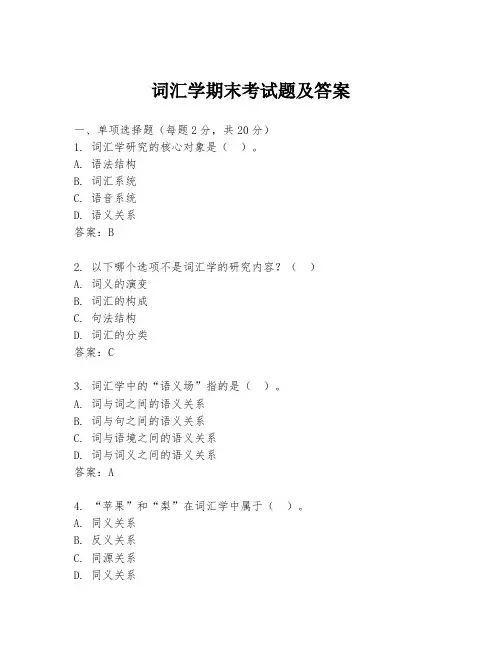
词汇学期末考试题及答案一、单项选择题(每题2分,共20分)1. 词汇学研究的核心对象是()。
A. 语法结构B. 词汇系统C. 语音系统D. 语义关系答案:B2. 以下哪个选项不是词汇学的研究内容?()A. 词义的演变B. 词汇的构成C. 句法结构D. 词汇的分类答案:C3. 词汇学中的“语义场”指的是()。
A. 词与词之间的语义关系B. 词与句之间的语义关系C. 词与语境之间的语义关系D. 词与词义之间的语义关系答案:A4. “苹果”和“梨”在词汇学中属于()。
A. 同义关系B. 反义关系C. 同源关系D. 同义关系5. 词汇学中,词义的最小单位是()。
A. 词根B. 词缀C. 词素D. 词组答案:C6. 以下哪个词不是通过合成法构成的?()A. 计算机B. 电视机C. 电冰箱D. 电答案:D7. 词汇学中,词义的扩大是指()。
A. 词义范围缩小B. 词义范围扩大C. 词义范围不变D. 词义范围模糊答案:B8. “老师”和“教授”在词汇学中属于()。
A. 同义关系B. 反义关系C. 包含关系D. 交叉关系答案:D9. 以下哪个词是通过转喻构成的?()B. 笔杆子C. 铁饭碗D. 纸老虎答案:B10. 词汇学中,词义的转移是指()。
A. 词义的增加B. 词义的减少C. 词义的不变D. 词义的转变答案:D二、填空题(每空1分,共20分)1. 词汇学是研究语言中的词汇现象和词汇系统的_________学科。
答案:语言学2. 词义的最小意义单位是_________。
答案:义素3. 词汇学中的“同义关系”指的是两个或多个词在_________上具有相同或相近的意义。
答案:语义4. 词义的引申是指词义从_________向_________的转移。
答案:具体;抽象5. 词汇学中的“反义关系”指的是两个词在_________上具有相反的意义。
答案:语义6. 词汇学中的“同源关系”指的是两个词在_________上具有共同的来源。
名词解释(10选5,一个4分)词=The minimal free form of a language, which has a given sound, meaning and syntactic function. 词根=The basic unchangeable part of a word, and covers the main lexical meaning of the word. 词缀=Affixes are forms that are attached to words or word elements to modify meaning or function. 一词多义=Polysemy =Polysemy means means means that that that one one one single single single word word word has has has two two two or or or more more senses at the same time. 同形异义=Homonyms =Homonyms are are are different different words words with with with the the the same same same form form (spelling or pronunciation) 完全同形异义=Perfect homonyms are different words identical both in sound and spelling, though different in meaning. 同音异形异义=Homophones are different words identical in sound but different in spelling and meaning. 同形异音异义=Homographs are different words identical in spelling, but different in sound or meaning. 同义关系=Synonymy Synonymy is is is a a a relationship relationship relationship of of of “sameness “sameness “sameness of of of meaning” meaning” that may hold between two words. 反义关系=Antonymy is a relationship of “meaning opposition” that may hold between two words. 上下义关系=Hyponymy is the sense relationship that relates words hierarchically. The underlying observation is that some words have a more general meaning, while others have a more specific meaning, while referring to the same entity. 问答题(6选3,一题10分)分)1. (1)What does onomatopoetic motivation mean?(2)What does semantic motivation mean?(3)Dose it contradict the statement that there is no natural connection between sound and meaning?Answer: (1)Onomatopoeic motivation means means defining defining defining the the the principle principle principle of of motivation by sound. (2)Semantic motivation means that motivation is based on semantic factors. (3)Facts (3)Facts have have have proved proved proved this this this argument argument to to be be be valid. valid. valid. W W ords ords that that convey convey the the the same same same meaning meaning meaning have have have different different different phonological phonological phonological forms forms forms in in different languages – (for example, English meat / mi:t /,Chinese ròròu. u. u. Alternatively, Alternatively, the the same same same phonological phonological phonological forms forms forms may may may convey convey different meanings - for example, sight, site, cite.) 2. How many kinds of meaning are there in English?Answer: Answer: There There There are are are 8 8 8 kinds kinds kinds of of of meaning meaning meaning in in in English, English, English, including including grammatical meaning, lexical meaning, denotative meaning, associative meaning, connotative meaning, social (stylistic) meaning, affective meaning, collocative meaning. 3. (1)What is context?(2)What role dose context play in linguistic communication? (以下答案摘自网络,回答稍冗长,请适当精简)Answer: (1)Context in its traditional sense refers to the lexical items that precede or follow a given word. And there is linguistic context, refers refers to to to the the the words, words, words, clauses, clauses, clauses, sentences, sentences, sentences, paragraphs, paragraphs, paragraphs, or or or whole whole books books in in in which which which a a a word word word appears. appears. appears. And And And extra-linguistic extra-linguistic extra-linguistic context, context, which which refers refers refers to to to a a a particular particular particular time, time, time, space, space, space, or or or culture culture culture in in in which which which a a word word appears. appears. appears. There There There also also also is is is lexical lexical lexical context: context: context: the the the lexemes lexemes lexemes that that co-occur with the word in question. The meaning of the word is affected or determined by the neighboring lexemes. (2)Context can function as followed: eliminating ambiguity; conveying emotional overtones; indicating referents and the range of the meaning of a word. 4.5. (1)What are the major types of synonymy?(2)(3)Explain those types with examples.Answer: (1)In (1)In general, general, general, English English English synonyms synonyms synonyms can can can be be be divided into divided into two two types: types: complete synonyms and relative synonyms. (2)Absolute synonyms are words whose meaning is fully identical in any context so that one can always be substituted for the other without t he slightest change in the slightest change in meaning. For example: (例子自己找)(例子自己找)(3)Relative synonyms refers to which denote different shades of meaning meaning or or or different different different degrees degrees degrees of of of a a a given given given quality. quality. quality. This This This kinds kinds kinds of of synonyms are the same in some degree such as (例子自己找)(例子自己找)6. (1)What are the major types of antonymy?(2)(3)(4)(5)Explain those types with examples.Answer: (1)There are four types of antonymy, including complementaries, gradable antonyms, relational opposites and semantic incompatibles (2)Complementaries (2)Complementaries refer refer refer to to to pairs pairs pairs of of of words words words that that that represent represent represent an an either/or relation. (例子找书去)(例子找书去)(3) Antonyms Antonyms of of of this this this type type type are are are best best best viewed viewed viewed in in in terms terms terms of of of a a a scale scale running running between between between two two two poles poles poles or or or extremes. extremes. extremes. The The The two two two opposites opposites opposites are are gradable. (例子找书去)(例子找书去)(4)The substitution of one member for the other does not change the the meaning of a sentence if it is accompanied by the change of meaning of a sentence if it is accompanied by the change of subject and object. (例子找书去)(例子找书去)(例子找书去) (5) (5) The The The words words words in in in a a a group group group of of semantic semantic incompatibles incompatibles incompatibles are are are in in contrast to the other members of the group, showing a contrastingness relationship between word and word (例子找书去)去)7. What are the possible causes of language change?(由于网上答案太泛,思路混乱,因此直接将课本原话翻译过来作为答案。
词汇学试题答案一、选择题1. 词汇学是研究什么的学科?A. 语言的发音规则B. 语言的词义变化C. 语言的句法结构D. 语言的词汇组成及其变化答案:D2. 下列哪个选项不是词汇学研究的范畴?A. 新词的产生B. 词义的演变C. 语言的修辞手法D. 词汇的借用答案:C3. “同义词”和“反义词”在词汇学中的关系是:A. 同义关系B. 对立关系C. 互补关系D. 包含关系答案:B4. 在汉语中,“苹果”和“iPhone”这两个词之间的关系最接近于:A. 一般与特殊B. 全体与部分C. 具体与抽象D. 同义与异义答案:A5. 词汇的多义性是指:A. 一个词只有一个含义B. 一个词有两个或以上的含义C. 一个词的含义随着语境变化D. 一个词的含义完全由字典定义答案:B二、填空题1. 词汇学的研究可以帮助我们更好地理解和掌握________的构成及其发展变化。
答案:语言2. 在词汇学中,________是指一个词汇在不同语境中可以表达不同的含义。
答案:词义的多样性3. 词汇的________是指词汇在语言发展过程中的增加、减少或形式的变化。
答案:演变4. “书山有路勤为径,学海无涯苦作舟”这句话中的“书山”和“学海”是________的运用。
答案:比喻5. 一个词的不同含义之间存在着某种联系,这种联系称为词义的________。
答案:关联三、简答题1. 请简述词汇学在语言学习和教学中的作用。
词汇学为语言学习者提供了一个系统的理论框架,帮助他们理解词汇的构成、词义的变化以及词汇在语境中的使用。
在教学中,教师可以利用词汇学的研究成果,设计更加有效的教学方法,如通过词根词缀的学习来扩展词汇量,或者通过词义的辨析来提高学生的语言理解能力。
此外,词汇学还可以帮助教师识别和解释学习者在词汇使用中可能出现的错误,从而更好地指导学习。
2. 举例说明词汇的借用现象。
词汇的借用是指一种语言从另一种语言中引入词汇,这些词汇可能是完全借用,也可能是经过一定程度的改造。
英语词汇学试题及答案一、选择题(每题2分,共20分)1. 词汇学研究的主要对象是什么?A. 语法结构B. 词汇构成C. 语音系统D. 语义关系2. 下列哪个词属于复合词?A. happyB. unicycleC. bicycleD. unhappy3. 词根是指什么?A. 单词的前缀B. 单词的后缀C. 单词的基本部分D. 单词的派生部分4. 词汇的同源词是指什么?A. 意义相近的词B. 形式相似的词C. 来源相同的词D. 功能相同的词5. 词汇的语义变化通常被称为什么?A. 词汇演变B. 词汇扩展C. 词汇借用D. 词汇创新二、填空题(每空2分,共20分)6. 英语中的词缀分为________和后缀。
7. 英语词汇的构成方式之一是________,例如:class + room = classroom。
8. 英语中的合成词是由两个或两个以上自由词组合而成的,如________。
9. 英语中,一个词的意义可能随着时间而发生变化,这种现象称为________。
10. 英语词汇学中的“词义扩展”是指一个词的意义范围________。
三、简答题(每题10分,共30分)11. 简述英语词汇的来源有哪些?12. 解释什么是词汇的同化现象,并给出一个例子。
13. 描述词汇的语义变化有哪些类型?四、论述题(每题15分,共30分)14. 论述英语词汇学在语言教学中的应用。
15. 分析英语词汇中的借词现象及其对英语发展的影响。
参考答案一、选择题1. B2. B3. C4. C5. A二、填空题6. 前缀7. 合成8. blackboard9. 语义演变10. 扩大或缩小三、简答题11. 英语词汇的来源包括:古英语、拉丁语、法语、希腊语、德语等。
12. 词汇的同化现象是指外来词在借用到另一种语言中时,为了适应新语言的发音规则而发生的改变。
例如,英语中的“sushi”在一些非英语国家可能会被读作“苏西”以适应当地语言的发音习惯。
词汇学试题及答案一、选择题(每题2分,共20分)1. 词汇学是研究语言中词汇的科学,它主要研究的是:A. 词汇的发音B. 词汇的意义C. 词汇的形态D. 词汇的用法答案:B2. 以下哪个选项不是词汇学研究的内容?A. 词汇的构成B. 词汇的分类C. 词汇的演变D. 词汇的发音规则答案:D3. 词汇学中“语义场”是指:A. 一个词的意义B. 一组词的意义关系C. 一个词的用法D. 一个词的形态变化答案:B4. 在词汇学中,“同义词”指的是:A. 意义完全相同的词B. 意义相近的词C. 形式相同的词D. 用法相同的词答案:B5. “词汇化”是指:A. 词汇的创造过程B. 词汇的消亡过程C. 词汇的借用过程D. 词汇的演变过程答案:A6. 词汇学中的“词义的引申”是指:A. 词义的减少B. 词义的增加C. 词义的变化D. 词义的固定答案:C7. “词汇的多义性”是指:A. 一个词有多个意义B. 一个词有多个用法C. 一个词有多种形态D. 一个词有多种发音答案:A8. 在词汇学中,“词义的模糊性”是指:A. 词义的不明确B. 词义的多样性C. 词义的稳定性D. 词义的一致性答案:A9. “词汇的固定搭配”在词汇学中通常指的是:A. 词与词之间的固定组合B. 词与词之间的临时组合C. 词与词之间的可变组合D. 词与词之间的随意组合答案:A10. “词汇的语义变化”通常包括:A. 词义的扩大B. 词义的缩小C. 词义的转移D. 所有以上选项答案:D二、填空题(每题2分,共20分)1. 词汇学中的“________”是指词义之间的相似性或相关性。
答案:同义性2. “________”是指词义之间的对立关系,如“黑”与“白”。
答案:反义性3. 词汇学中的“________”是指词义的抽象化或具体化。
答案:词义的层次性4. “________”是指一个词在特定语境中的意义,与词典中的标准意义不同。
答案:语境义5. “________”是指词义的扩展,使得一个词可以指代更广泛的事物或概念。
大学词汇学试题及答案一、选择题(每题2分,共20分)1. The word "chronic" is most closely related to which of the following?A. AcuteB. TemporaryC. SeasonalD. Chronic2. In the context of a business meeting, "feasibility" refers to the:A. Ability to flyB. Ability to be doneC. Ability to swimD. Ability to run3. "Paradox" is a term that is associated with:A. A simple truthB. A complex lieC. A situation that contradicts itselfD. A straightforward problem4. The term "epidemic" is used to describe a:A. Single occurrenceB. Small groupC. Widespread occurrenceD. Limited occurrence5. "Symbiotic" relationships are characterized by:A. Mutual harmB. Mutual benefitC. One-sided benefitD. No interaction6. "Euphemism" is a term used to describe:A. A harsh truthB. A polite lieC. A direct statementD. A hidden meaning7. "Intrinsic" value refers to the value that is:A. Externally imposedB. Internally inherentC. Externally visibleD. Internally hidden8. The word "analogous" is used to describe something that is:A. Completely differentB. Partially similarC. Exactly the sameD. Totally unrelated9. "Dichotomy" refers to a division into:A. Three partsB. Two partsC. Four partsD. Five parts10. "Ephemeral" is a term that is used to describe somethingthat is:A. Long-lastingB. Short-livedC. EternalD. Timeless二、填空题(每题1分,共10分)11. The opposite of "visible" is _______.12. A synonym for "unpredictable" is _______.13. The term "hierarchy" refers to a _______ of authority or rank.14. "Ambiguous" means having more than one _______.15. "Chronology" is the arrangement of events in the order of their _______.16. "Catastrophe" is a term used to describe a sudden event causing great _______.17. "Democracy" is a system of government by the whole_______.18. "Eloquence" is the quality of speaking or writing that is fluent and _______.19. "Frugality" is the quality of being economical with money or resources, often to an _______ extent.20. "Hypothesis" is a proposed explanation for a phenomenon, made on the basis of limited evidence as a starting point for further _______.三、简答题(每题5分,共20分)21. Define the term "metaphor" and provide an example.22. Explain the difference between "allegory" and "simile".23. What does the term "prose" refer to in literature?24. Describe the concept of "synecdoche" and give an example.四、论述题(每题10分,共20分)25. Discuss the importance of understanding etymology in the study of vocabulary.26. Analyze the role of idioms in communication and how they can sometimes lead to misunderstandings.答案:一、选择题1. D2. B3. C4. C5. B6. B7. B8. B9. B10. B二、填空题11. invisible12. unpredictable13. system14. meaning15. occurrence16. damage17. population18. persuasive19. excessive20. investigation三、简答题21. A metaphor is a figure of speech that describes an object or action in a way that isn't literally true, but helps explain an idea or make a comparison. For example, "Time is a thief" is a metaphor that personifies time as a thief, suggesting that it steals our moments.22. An allegory is a narrative that conveys a deeper meaning beneath the surface, often using characters and events to represent abstract concepts or moral lessons. A simile, on the other hand, is a direct comparison between two unlike things using "like" or "as," such as "She is as brave as a lion."23. Prose is a form of language that has a natural flow of speech and normal grammatical structure rather than a rhythmic structure, unlike poetry. It is the ordinary form of language used in speech or writing.24. Synecdoche is a figure of speech in which a part is made to represent the whole or vice versa。
词汇学语言考试题及答案一、选择题(每题2分,共20分)1. 词汇学是研究语言中词汇的系统、结构和变化规律的学科,它属于:A. 语音学B. 语法学C. 词汇学D. 语义学答案:C2. 下列哪个选项不是词汇学研究的内容?A. 词汇的构成B. 词汇的分类C. 词汇的演变D. 语音的发音答案:D3. 词汇学中,词根是指:A. 词的基本意义单位B. 词的发音单位C. 词的书写单位D. 词的语法单位答案:A4. 以下哪个词是由两个词根组成的?A. 苹果B. 汽车C. 电脑D. 葡萄答案:B5. 词汇学中的“同义词”指的是:A. 意义完全相同的词B. 意义相近的词C. 意义相反的词D. 意义完全不同的词答案:B6. 在词汇学中,“反义词”是指:A. 意义相近的词B. 意义相反的词C. 意义相同的词D. 意义不相关的词答案:B7. “词汇化”是指:A. 词汇的创造过程B. 词汇的消失过程C. 词汇的演变过程D. 词汇的分类过程答案:A8. 词汇学中的“语义场”是指:A. 词的发音范围B. 词的书写范围C. 词的意义范围D. 词的使用范围答案:C9. 词汇学中,“多义词”是指:A. 只有一个意义的词B. 有两个或两个以上意义的词C. 没有意义或意义不明确的词D. 意义完全相反的词答案:B10. 词汇学中的“同音词”是指:A. 发音相同的词B. 意义相同的词C. 书写相同的词D. 用法相同的词答案:A二、填空题(每题2分,共20分)11. 词汇学中的“词缀”是指附着在词根上,用来构成新词的________。
答案:语素12. “派生”是指通过添加________来创造新词的过程。
答案:词缀13. “合成”是指通过合并________来创造新词的过程。
答案:词根14. “词汇变化”包括词义的________、________和________。
答案:扩大、缩小、转移15. “词汇的语义变化”是指词义的________、________和________。
词汇学复习题
1、什么是词?什么是词汇?
词有各种定义,一般来讲,词是最小的能独立运用的语言单位。
词汇是语言中词语的总和,它包括语言中的词和固定语。
固定语是语言中可以把词作为构成成分的、同词一样作为整体来运用的语言单位。
2、词汇学研究如何分类?它有什么实践作用?
词汇学以词和词汇为研究对象。
它可以分为具体词汇学(研究一种语言的词汇)和一般词汇学(研究词汇的一般理论),历史词汇学(研究词的本义,最早的形式和它的发展)和描写词汇学(研究一个时期的词汇),还有历史比较词汇学(比较有亲属关系的语言的词,以构拟它们在共同的母语中的形式和意义)。
比如现代汉语词汇学,属于具体的描写的词汇学。
词汇学的实践作用:(一)有助于提高语言运用能力;(二)有助于语文教学;(三)有助于现代汉语词汇规范化的工作。
3、简单介绍《哈工大同义词林扩展版》以及董振东的知网(How-Net)。
《哈工大同义词词林扩展版》是哈尔滨工业大学信息检索实验室在梅家驹《同义词词林》的基础上扩充而成,它增加了两个级别的编码,采用五级编码,总的词汇量也由原来的四万多条增加到六万多条。
所有这些词都归入设计的编码体系中。
按董振东的说法,知网(How-Net)是一个以汉语和英语的词语所代表的概念为描述对象,以揭示概念与概念之间以及概念所具有的属性之间的关系为基本内容的常识知识库。
4、词汇的计量研究涉及频次、频率,分布率,使用率,流通度等概念,请解释这几个概念。
频次指词在语料中出现的次数,频率等于它的频次除以语料所有词频次的总和。
分布率等于词出现的文本数除以总的文本数。
使用率等于频率乘以分布率。
流通度等于流通量(发行量)*流通密度(发行周期)*流通空间(发行范围)*流通率(阅读率)
5、简要说明异形词和同形词。
异形词指同一个词有不同的书写形式,如“制伏——制服”。
同形词指书写形式相同的词,包括同形同音词、同形异音词,它们是不同的词。
6、简要说明合成词词义和构成它的语素意义的关系。
合成词和构成它的语素义的关系:
(一)词义是语素义按照构词方式所确定的关系组合起来的意义。
(二)词义同组成它的两个语素相同、相近,它们是并列结构的合成词。
(三)合成词的语素义表示了词义的某些内容。
(四)合成词的词义是语素义的比喻用法。
(五)合成词的词义是语素义的借代用法。
(六)合成词中有的语素义失落原义。
7、在共时的平面上,词汇的系统性体现在哪几个方面?
(一)词的结构的系统性
大多数词都可以归入少数几个结构类型中,词在结构上很有规则地联系在一起,表现出组织结构上的系统性。
(二)词义关系的系统性
从词的意义关系来说,词可以构成层次关系和非层次关系。
层次关系有上下位关系、整体部分关系、亲属关系、等级关系等。
非层次关系有同义、反义、同位等关系。
(三)同族词的系统性
汉语的同族词体现出词汇的系统性。
同族词中各个合成词意义上有联系。
在结构平面上,与其他语素结合,组成并列、偏正、支配、附加等结构的合成词,体现出结构上的系统性、规律性。
8、分析下列两组同义词:
典范,范例;糟蹋,浪费
“典范”指可以作为学习、仿效标准的人或事物。
“范例”指可以仿效的事例。
意义相近,区别在于前者带有“因为体现了某种标准而可以学习、效仿”的意思,后者没有这个意思,或者说程度不及前者。
此外,后者一般指“事例”,前者还可以指“人”。
在搭配上,“范例”可以与量词“个”搭配,而“典范”几乎不和量词搭配。
“糟蹋”有两个意义:一是浪费,损坏;二是蹂躏,侮辱。
“浪费”只有一个意义,指对财物、人力、时间等用得不当或无节制,与“糟蹋”的第一个意义形成同义关系。
“糟蹋”有“损坏”的意思,而“浪费”没有。
此外,“浪费”是在做某事过程中,对物品的不当使用,“糟蹋”的结果虽然也包含了浪费,但不一定是在做某事的过程中发生的。
还有,我们可以说“这样做很浪费”但不能说“这样做很糟蹋”。
9、现代汉语词汇规范化工作主要包括哪些内容?
主要包括:
(1)方言词问题
(2)文言词语问题
(3)外来词问题
(4)生造词的问题
(5)普通话词汇用法的规范问题
(6)术语的统一问题
(7)编纂现代汉语规范化的详解词典
10、现代汉语词汇由哪几部分构成?
词汇包括词和固定语,其中固定语包括专门用语、熟语和习用词组。
专门用语包括专名词语、术语、行业语,熟语包括成语、歇后语、谚语、惯用语。
11、词在运用中受到各种制约和影响,词义表现出差异,有人因此认为“词没有一般的意义,我们每次都赋予同一个词以新的意义”,你怎么看这个问题?
这种现象是由词义的性质决定的,词义是概括的,它在不同的上下文中、语境中会有不同的具体内容。
以名词“船”为例:
(1)海上的船很多。
(2)海面上漂着一条船。
(3)这船真大。
(4)这船真漂亮。
(5)这般真结实。
(6)他要坐船去欧洲。
(7)船泊在小河边树下。
(1)、(2)中的“船”指船这一事物对象,(3)侧重指船的体积容量,(4)侧重指船的形式装饰,(5)侧重指船的结构,(6)指大轮船,(7)指小木船。
但它们都有共同的指示对象,即作为运输工具的“船”。
12、请说明分析词构造的传统方法,以及这种分析方法存在的问题。
因为这种方法存在一些问题,有人提出的新的分析方法。
你怎么看这种现象?
传统的构词分析法是这样:一般认为,由一个语素构成的是单纯词,由两个及两个以上的语素构成的词是合成词。
单纯词可以从其音节特征划分类型,合成词可以从分析构成它的语素之间的关系划分类型。
单纯词可以分为:单音节、双音节、三音节、四音节以上。
各类可从来源上划译音词、拟声词等。
两个音节的还可以从声母、韵母的特征分为双声、叠韵、叠音、非双声叠韵等。
合成词的分析将合成词分解为词根和词缀,全部合成词的结构分析可以分为“词根+词根”和“词根+词缀”两大类型,前者再分为偏正、并列、支配、陈述、补充、重叠等类型,后者再分为前附加、后附加等类型。
这些类型可以有各种组合,成为多层结构。
这种划分的基础,是分析词的构成成分的意义、作用及其间的关系。
这种分析方法存在一些问题:
(一)并未涵盖现代汉语合成词结构的各种情况
(二)所提出的“词根”概念有一定的解释力,但对于像“人民性”(人民+性)、“急性子”(急+性子)、“无产阶级”(无产+阶级)这些词,包含有词作为构成成分,分析为由语素作为构成成分组成的合成词,不太恰当。
(三)所提出的“词缀”概念,范围不清,争论较大。
上述是传统分析方法存在的问题,但是我们认为,尽管如此,这种方法在教学上是有用有效的。
有人提出了其他的分析方法,虽然可以覆盖更多的合成词,但不一定适合于教学。
此外,我们认为,对于同一个现象,我们可以采用不同的理论的分析解释它,其中越简洁、解释力越强的理论就是好理论。